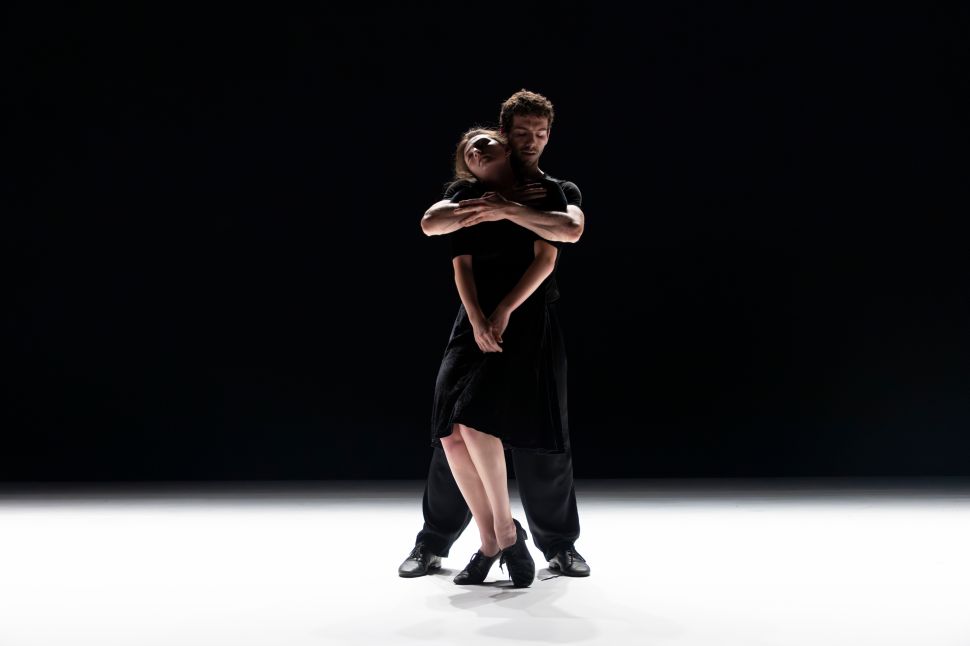Gibney Company is back at the Joyce Theater. The dance troupe, founded in 1991 in New York City by artistic director and CEO Gina Gibney, is a creation-based repertory company, meaning it focuses on commissioning new works from emerging and renowned choreographers while also presenting Gibney’s work. It’s known for its dedication to social justice; all the dancers, here called “artistic associates,” are activists as well as artists and are arguably the company’s greatest strength. The Joyce program’s lineup, featuring two world premieres and one U.S. premiere, is a showcase for those incredible performers and a testament to the company’s aesthetic range.
Opening the program is the U.S. premiere of Israeli choreographer Roy Assaf’s A Couple, excerpted from his evening-length work Figure No. 16 (2020). When I attended on May 6, the duet was performed by Graham Feeny and Zack Sommer, though three casts will perform the piece throughout the week. It begins before it begins, with dancer Madi Tanguay addressing the audience from a microphone at the edge of the stage, sharing her disappointment that she isn’t performing this piece on opening night and suggesting the audience do pelvic floor exercises whenever they feel the urge to check their cell phones. “Gather, and release,” she instructs, “but never, ever squeeze.”
This unexpected comedic bit delighted those around me and shifted the air in the room. The audience was wide-eyed and smiling, ready for anything when the piece truly began. Then two dancers run onto the stage, dressed in tight black t-shirts, pants and jazz shoes (the simple-sleek costume design by Assaf with Victoria Bek). They immediately begin to move, as if picking up a conversation mid-sentence. It’s all arms and legs at first, big gestures and swings, almost clownish. Their dynamic is playful and platonic. The choreography mimics the rhythm of the piano keys enjoyably, though sometimes too closely (the music is a series of Johannes Brahms compositions).
SEE ALSO: As NEA Cuts Hit Hard, Arts Groups Are Readying Their Fundraising Pitches
As the couple moves through several distinct sections, their dynamic changes, and the movement quality does, too. They slow down and become more tender. There is an almost-kiss. There is a face slap. They hold each other’s weight and carry each other around. They fall and roll across the entire stage. The physical metaphors of love in its myriad forms are clear and touching. So much of the work’s power is rooted in the couple’s chemistry (here light and jovial), and I found myself wishing I could see the piece again and again with the other two casts to see how it would change when performed by different duos.
The second piece is the world premiere of Echoes of Sole and Animal by American choreographer Peter Chu. Chu has long been interested in traditional Chinese medicine and says its values have influenced him as a creator. In this work, according to the program note, he also draws on qigong and taiji principles.
As soon as the two dancers walk onto the stage, it is clear that something internal and energetic is afoot. We hear the footsteps from their hard shoes and also in the spare soundscape. They both throw around their legs, stiff and with turned-in feet. The energy feels stagnant—it isn’t moving through. Then a third dancer (Tanguay) comes onto the stage and collapses, and with that, the beat drops. More dancers join (eight in all), Djeff Houle’s musical score swells and the movement grows fluid. The group undulates like jellyfish while Tanguay stands aside and gapes her mouth like a fish. Her story feels separate from or maybe parallel to the group’s and continues to feel so throughout the piece.
The dancers move languidly, sometimes heavily, through the work in lovely earth brown costumes designed by Chu with Caitlin Taylor. The lighting design, by Asami Morita, is especially provocative, with a hand-held light and near-darkness at times. The group’s energy keeps moving and escalates, turning more internal and animalistic. At one point, a dancer walks on all fours, her hands in a pair of shoes. Someone vocalizes into a microphone, speaking in guttural not-quite words, getting louder and louder. Something happens, though I can’t say exactly what, and I think that ambiguity is purposeful. Tanguay’s performance was especially exquisite.
Closing the program is the world premiere of Lucinda Childs’ Three Dances (for prepared piano) John Cage. Childs (of Judson Dance Theater fame) has been in the downtown dance scene since 1963. Her work is known for its mathematical precision, structured repetition and geometric patterns, and this new one is no exception.
The piece, set to Cage’s 1944-45 composition Three Dances, begins when eight dancers clad in flowy gray tank tops and pants, designed by Karen Young, walk onto the bare stage (it’s interesting that all three pieces in the program begin with dancers walking onto the stage) and take their “neutral” (standing, facing front, blank-faced) positions. They come in and out of this neutral position throughout, diving on cue into the strict movement score—it feels very much like a score, in conversation with Cage’s polyrhythmic one—which is all about lines and angles and the breaking of lines with an occasional curve. The choreography is obviously difficult in its musicality and precision, and the ensemble did an amazing job executing it. It didn’t show any of the usual growing pains that world premieres often do. In fact, it looked well-worn on their bodies.
What a delight it was to watch the company tackle such drastically different styles and moods throughout the evening. While the new works are promising, it was the dancers themselves who stole the show.
Gibney Dance is performing at The Joyce Theater in New York City through May 11, 2025.

